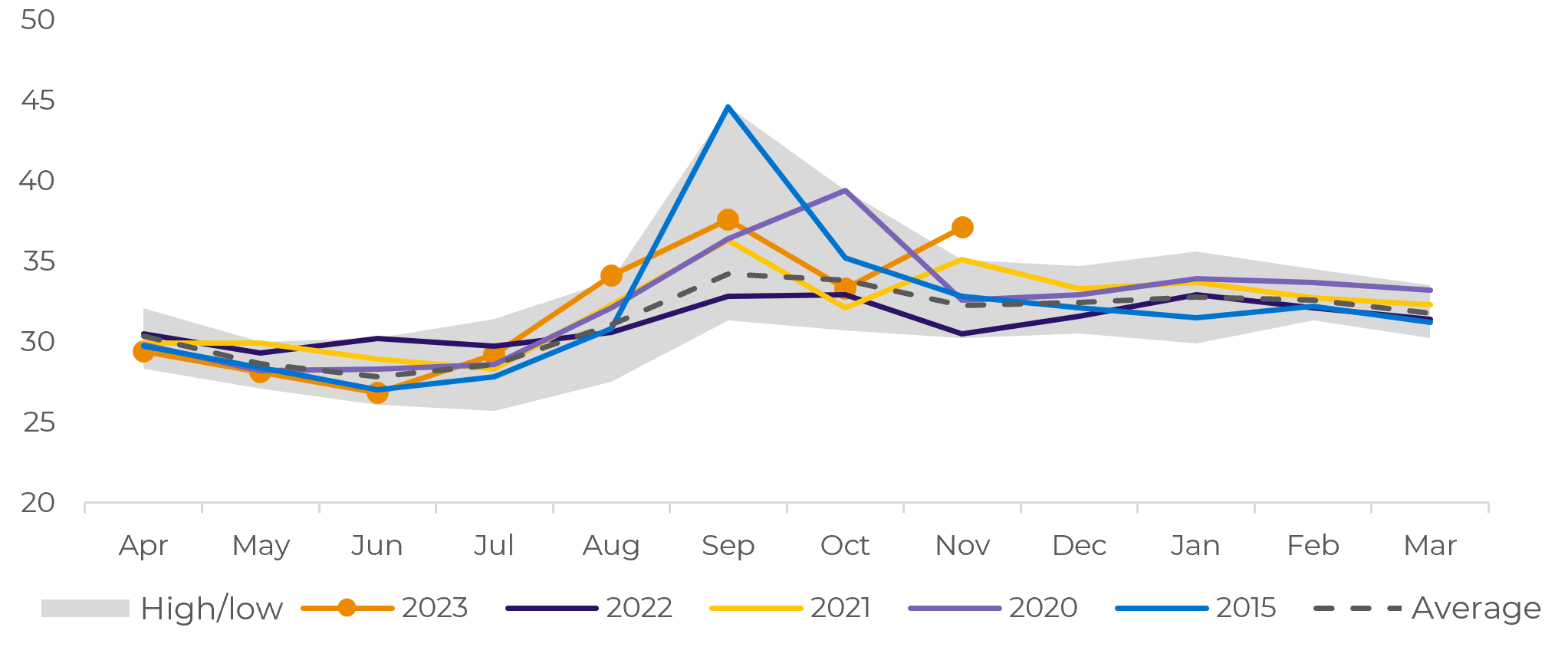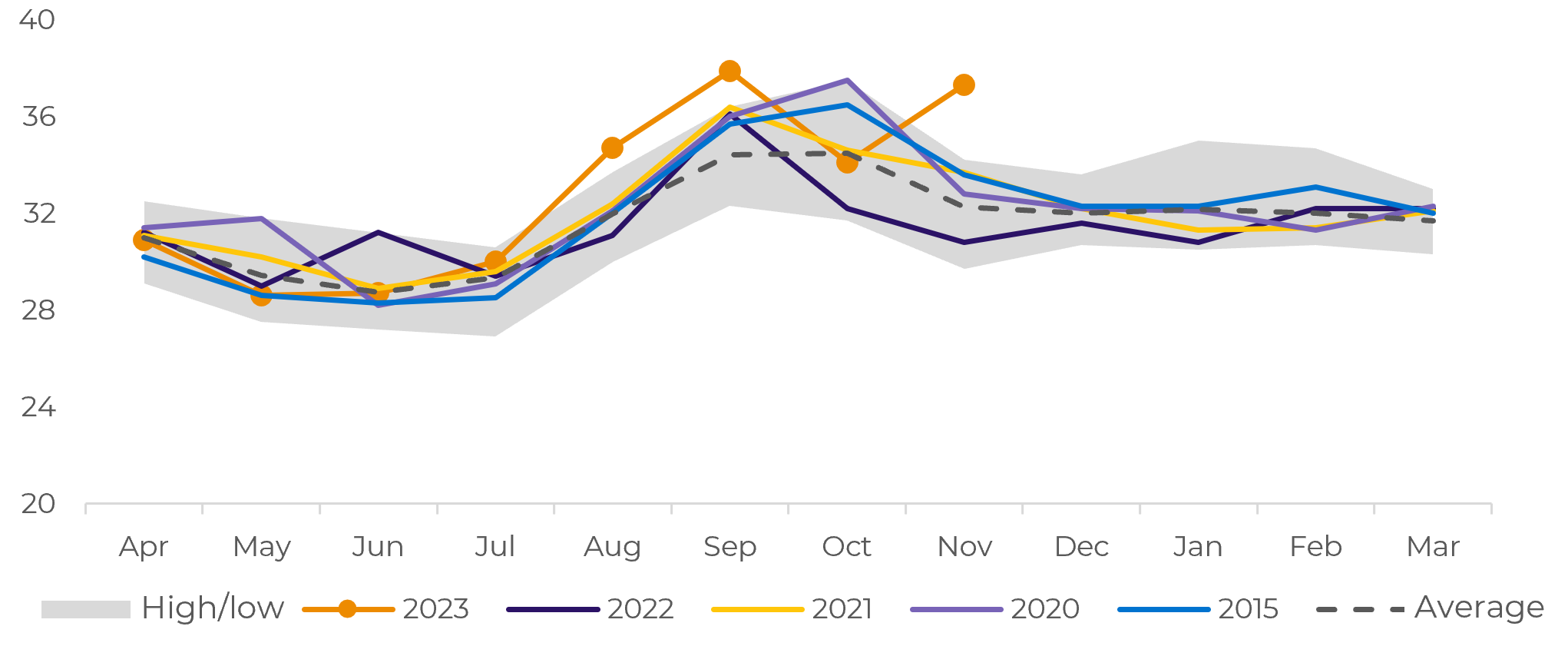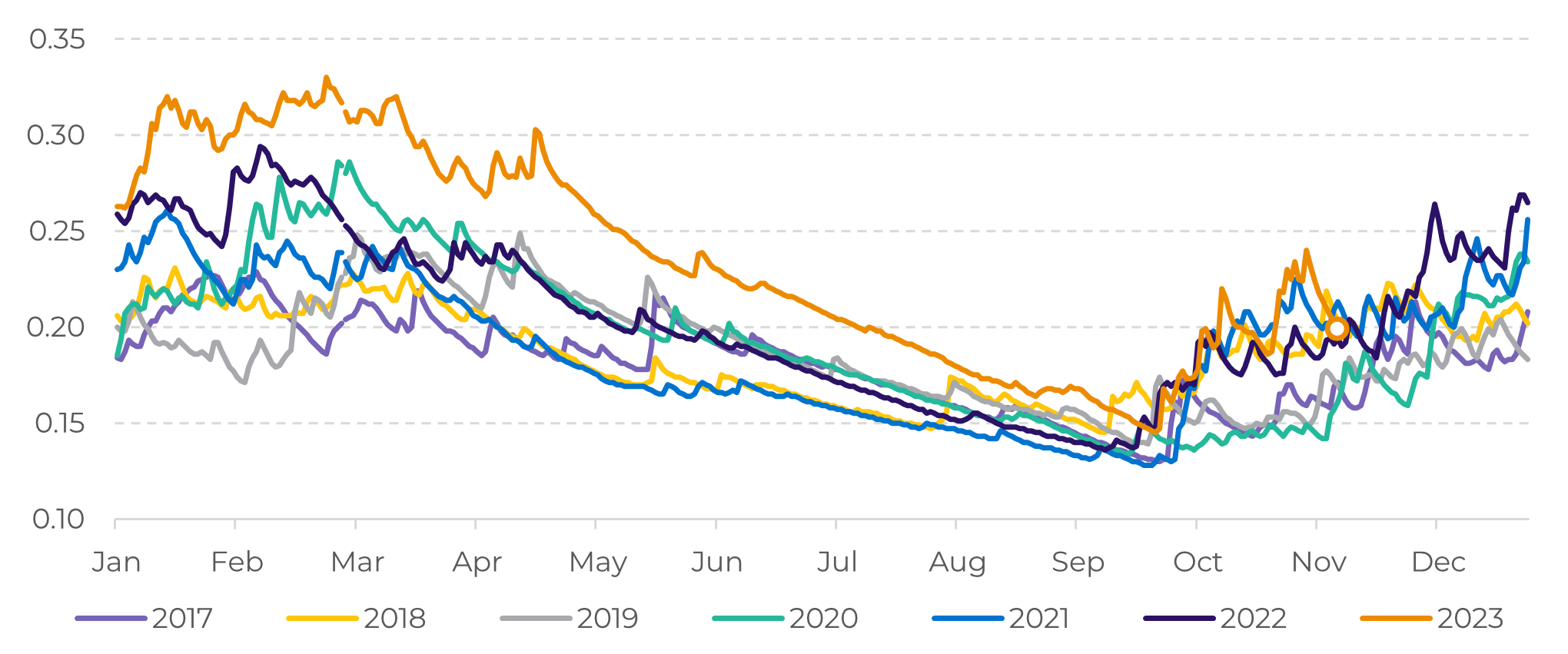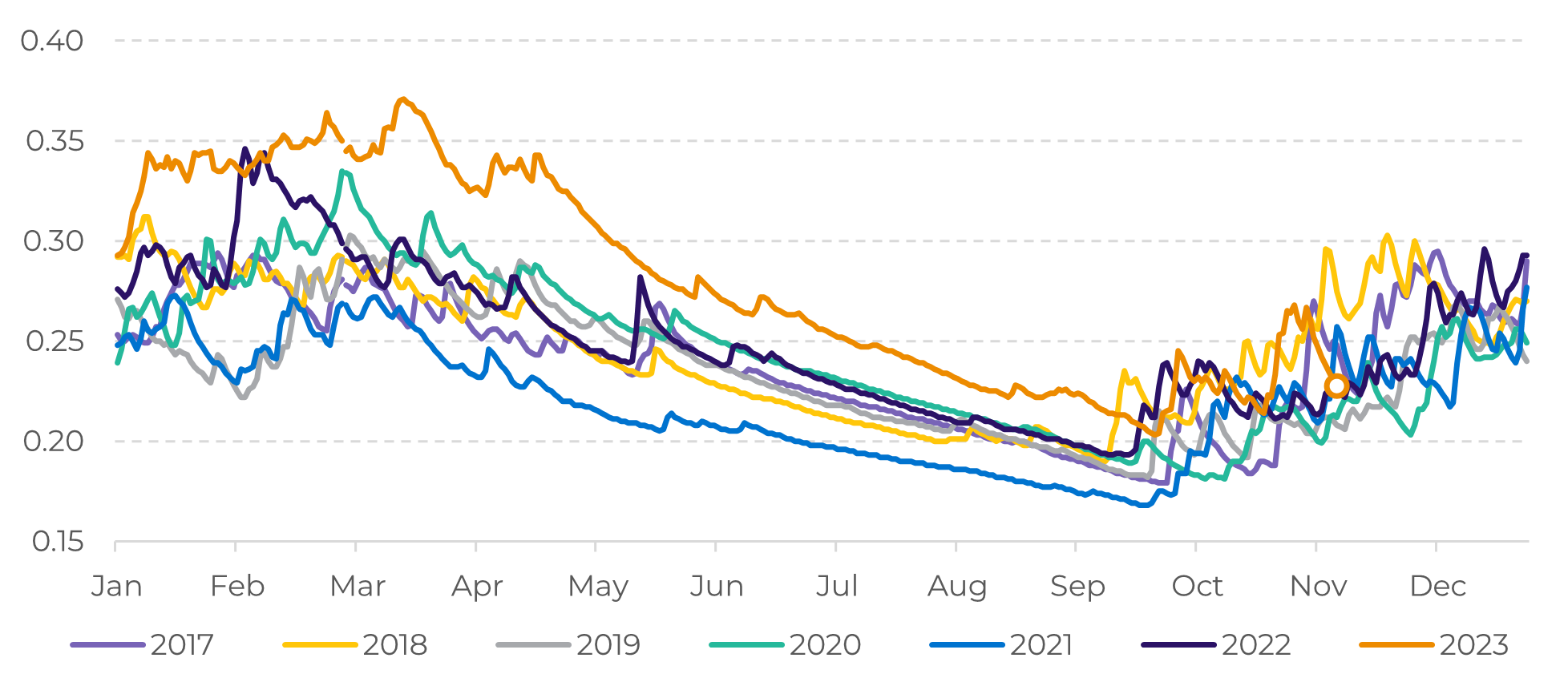
Nov 17
Coffee Weekly Report - 2023 11 17
Back to main blog page
- Ongoing El Niño-induced heatwave in Brazil raises concerns for 24/25 coffee crop. Três Pontas and Patrocínio reported the highest temperatures in 20 years.
- Unlike the 21/22 crop failure due to heat and drought, the current weather hasn't impacted tree development yet. Soil moisture levels for 2023, although decreased, are closer to historical averages than the critical 2020 lows.
- Weather forecasts predict upcoming rain and a temperature drop, providing relief expected to safeguard coffee crop from significant damage. The 7-day forecast indicates higher temperatures in Cerrado until November 24, followed by a gradual decrease in the heatwave's intensity.
- The critical period remains, but overall conditions suggest potential resilience for the 24/25 coffee crop in Brazil, urging cautious optimism in the agricultural outlook.
Brazil's Coffee Crop: Navigating the current heatwave
The heatwave in Brazil is raising concerns regarding the development of the 24/25 coffee crop – a direct impact of the currently active El Niño over coffee producing areas.
Some regions, such as Três Pontas in the South of Minas Gerais, or Patrocínio, in Cerrado, are already reporting the highest temperatures in 20 years. In this analysis, we will consider both cities as a proxy for their regions.
Still, it’s important to note that the increase in temperatures to record-high levels was not uniform across all cities. For other main cities (such as Campos Gerais and Machado), 2020 was the warmest year – which then led to the 21/22 crop failure.
Another point also needs to be addressed: whereas those temperatures alongside drought led to the 21/22 crop failure, this time around, the period of vegetative development of the trees was not affected by water stress, as was the case back then. Only the persistence of this weather pattern can reduce yields for the next crop, especially in regions that were already affected by broca, which thrives under warm weather.
Image 1: Maximum Temperature – Três Pontas (°C)

Source: Somar, Bloomberg, hEDGEpoint
Image 2: Maximum Temperature – Patrocínio (°C)

Source: Somar, Bloomberg, hEDGEpoint
Part of the reason that concerns are more abated when compared to the same period in 2020 is that soil moisture levels are not at the same low levels as seen prior to the 21/22 crop failure.
Charts #3 and #4 show soil moisture levels for 2023 and the previous 6 years, with 2020 marking the lowest level for mid-November in both regions. Comparatively, 2023 is in the middle of the pack, closer to the historical averages.
Nonetheless, it’s important to note that soil moisture levels have decreased during a time when they should have increased, and there’s less leeway for Cerrado than for South of Minas Gerais (or the remaining main-producing regions, for that matter).
In this sense, the current weather scenario does not pose any major threats to the 24/25 crop, provided that it does not remain with the same conditions for long. Weather forecast models suggest that rains will return in the next 7-day period, also alleviating the warm temperatures. Starting on November 17 through November 24, temperatures can still be 4-6 °C higher than average in Cerrado, and 1-4 °C in other regions. Starting on November 25, the extent of the current heatwave is expected to lose some strength.
Image 3: Average Soil Moisture – South of Minas Gerais (mm in top 1.0m soil)

Source: Refinitiv, hEDGEpoint
Image 4: Average Soil Moisture – Cerrado (mm in top 1.0m soil)

Source: Refinitiv, hEDGEpoint
In Summary
The current El Niño-induced heatwave in Brazil sparks worries for the 24/25 coffee crop, with Três Pontas and Patrocínio reporting the highest temperatures in two decades. Unlike the 21/22 crop failure caused by heat and drought, the present weather hasn't impacted tree development.
Soil moisture levels for 2023, although decreased, are closer to historical averages than the critical 2020 lows. While concerns persist, the immediate threat to the 24/25 crop is somewhat alleviated by better soil moisture. Weather forecasts indicate upcoming rain and a temperature drop, providing relief and potentially safeguarding the coffee crop from significant damage.
Weekly Report — Coffee
Written by Natália Gandolphi
natalia.gandolphi@hedgepointglobal.com
natalia.gandolphi@hedgepointglobal.com
Reviewed by Lívea Coda
livea.coda@hedgepointglobal.com
www.hedgepointglobal.com
Disclaimer
This document has been prepared by hEDGEpoint Global Markets LLC and its affiliates ("HPGM") exclusively for informational and instructional purposes, without the purpose of creating obligations or commitments with third parties, and is not intended to promote an offer, or solicitation of an offer, to sell or buy any securities or investment products. HPGM and its associates expressly disclaim any use of the information contained herein that may result in direct or indirect damage of any kind. If you have any questions that are not resolved in the first instance of contact with the client (client.services@hedgepointglobal.com), please contact our internal ombudsman channel (ouvidoria@hedgepointglobal.com) or 0800-878-8408 (for clients in Brazil only).
Contact us
hedgepointhub.support@hedgepointglobal.com
ouvidoria@hedgepointglobal.com
Funchal Street, 418, 18º floor - Vila Olímpia São Paulo, SP, Brasil
This page has been prepared by Hedgepoint Schweiz AG and its affiliates (“Hedgepoint”) solely for informational and instructional purposes, without the purpose of instituting obligations or commitments to third parties, nor is it intended to promote an offer, or solicitation of an offer of sale or purchase relating to any securities, commodities interests or investment products. Hedgepoint and its associates expressly disclaim any use of the information contained herein that directly or indirectly result in damages or damages of any kind. Information is obtained from sources which we believe to be reliable, but we do not warrant or guarantee the timeliness or accuracy of this information. The trading of commodities interests such as futures, options, and swaps involves substantial risk of loss and may not be suitable for all investors. You should carefully consider wither such trading is suitable for you in light of your financial condition. Past performance is not necessarily indicative of future results. Customers should rely on their own independent judgement and/or advisors before entering in any transaction.Hedgepoint does not provide legal, tax or accounting advice and you are responsible for seeking any such advice separately.Hedgepoint Schweiz AG is organized, incorporated, and existing under the laws of Switzerland, is filiated to ARIF, the Association Romande des Intermédiaires Financiers, which is a FINMA-authorized Self-Regulatory Organization. Hedgepoint Commodities LLC is organized, incorporated, and existing under the laws of the USA, and is authorized and regulated by the Commodity Futures Trading Commission (CFTC) and a member of the National Futures Association (NFA) to act as an Introducing Broker and Commodity Trading Advisor. HedgePoint Global Markets Limited is Regulated by the Dubai Financial Services Authority. The content is directed at Professional Clients and not Retail Clients. Hedgepoint Global Markets PTE. Ltd is organized, incorporated, and existing under the laws of Singapore, exempted from obtaining a financial services license as per the Second Schedule of the Securities and Futures (Licensing and Conduct of Business) Act, by the Monetary Authority of Singapore (MAS). Hedgepoint Global Markets DTVM Ltda. is authorized and regulated in Brazil by the Central Bank of Brazil (BCB) and the Brazilian Securities Commission (CVM). Hedgepoint Serviços Ltda. is organized, incorporated, and existing under the laws of Brazil. Hedgepoint Global Markets S.A. is organized, incorporated, and existing under the laws of Uruguay. In case of questions not resolved by the first instance of customer contact (client.services@Hedgepointglobal.com), please contact internal ombudsman channel (ombudsman@hedgepointglobal.com – global or ouvidoria@hedgepointglobal.com – Brazil only) or call 0800-8788408 (Brazil only).Integrity, ethics, and transparency are values that guide our culture. To further strengthen our practices, Hedgepoint has a whistleblower channel for employees and third-parties by e-mail ethicline@hedgepointglobal.com or forms Ethic Line – Hedgepoint Global Markets.Security note: All contacts with customers and partners are conducted exclusively through our domain @hedgepointglobal.com. Do not accept any information, bills, statements or requests from different domains and pay special attention to any variations in letters or spelling, as they may indicate a fraudulent situation.“HedgePoint” and the “HedgePoint” logo are marks for the exclusive use of HedgePoint and/or its affiliates. Use or reproduction is prohibited, unless expressly authorized by HedgePoint. Furthermore, the use of any other marks in this document has been authorized for identification purposes only. It does not, therefore, imply any rights of HedgePoint in these marks or imply endorsement, association or seal by the owners of these marks with HedgePoint or its affiliates.

